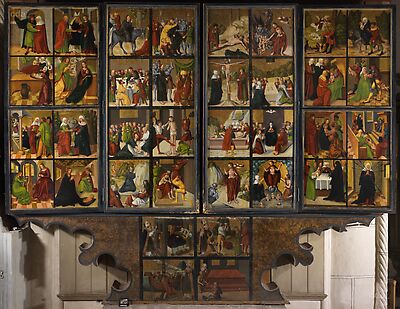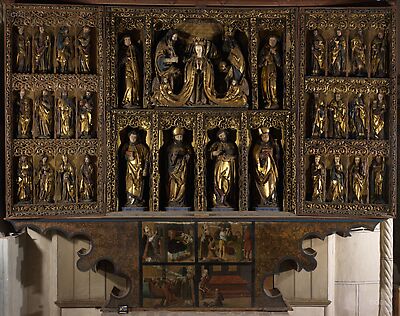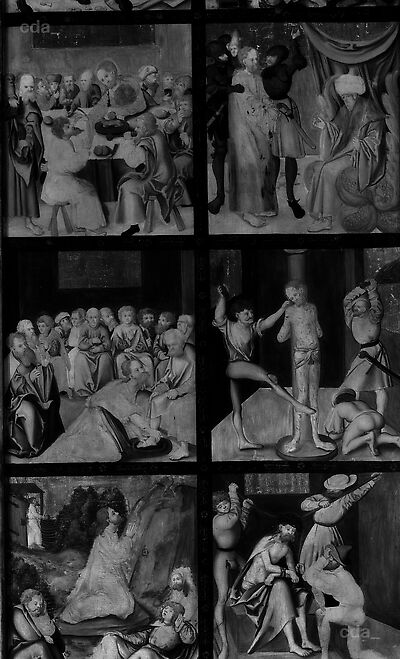Christ entering Jerusalem (no infrared reflectogram available)
The Last Supper
DESCRIPTION
Tools/Material:
- fluid, black medium, brush (?)
Type/Ductus:
- freehand underdrawing after a pre-existing design
- thin lines
Function:
- binding for the final painted version; the lines define the main contours and describe essential details and facial features; no representation of volume with hatching strokes
Deviations:
- minor corrections were made to forms during the painting process; small changes
INTERPRETATION
Attribution:
- not possible (not Cranach workshop)
The Washing of the Feet
DESCRIPTION
Tools/Material:
- fluid, black medium, brush
Type/Ductus:
- relatively detailed and freehand underdrawing
- thin lines
Function:
- binding for the final painted version; the lines define the main contours and describe esssential details and facial features; no representation of volume with hatching strokes
Deviations:
- only very minor corrections were made to the forms during the painting process, small changes
INTERPRETATION
Attribution:
- not possible (not Cranach workshop)
Agony in the Garden
DESCRIPTION
Tools/Material:
- fluid, black medium, brush (?)
Type/Ductus:
- relatively detailed and freehand underdrawing after a pre-existing design
- thin lines
Function:
- binding for the final painted version; the lines define the main contours and describe essential details and facial features; no representation of volume with hatching strokes
Deviations:
- only very minor corrects were made to forms during the painting process; almost no changes
INTERPRETATION
Attribution:
- not possible (not Cranach workshop)
The Arrest of Christ (an infrared reflectogram is not available)
Christ before Pilate
DESCRIPTION
Tools/Material:
- fluid, black medium, brush
Type/Ductus:
- freehand underdrawing after a pre-existing design
- thin lines
Function:
- relatively binding for the final painted version; the lines define the main contours and describe essential details and facial features; no representation of volume with hatching strokes
Deviations:
- small corrections were made to forms during the painting process; small changes
INTERPRETATION
Attribution:
- not possible (not Cranach workshop)
The Flagellation
DESCRIPTION
Tools/Material:
- stylus (?)
Type/Ductus:
- detailed and freehand underdrawing after a pre-existing design
- thin, delicate lines
Function:
- binding for the final painted version; the lines define the main contours and describe essential details and facial features; no representation of volume with hatching strokes
Deviations:
- only very minor corrections were made to forms during the painting process; small changes
INTERPRETATION
Attribution:
- not possible (not Cranach workshop)
The Crowning of Thorns and the Mocking of Christ
DESCRIPTION
Tools/Material:
- fluid, black medium, brush
Type/Ductus:
- freehand underdrawing after a pre-existing design
- thin lines
Function:
- binding fort he final painted version; the lines define the main contours and describe essential details and facial features; no representation of volume with hatching strokes
Deviations:
- almost no corrections were made to forms during the painting process; small changes
INTERPRETATION
Attribution:
- not possible (not Cranach workshop)
[Sandner, Heydenreich, Smith-Contini, cda 2017]
![The Bernau Altarpiece [left inner wing]: Passion of Christ [verso]](https://lucascranach.org/imageserver-2022/DE_StMB_NONE-001a_FR-none/01_Overall/DE_StMB_NONE-001a_FR-none_2016-02_Overall-s.jpg)

![The Bernau Altarpiece [left alteration wing]: Live of the Virgin [recto], Live of Saints [verso]](https://lucascranach.org/imageserver-2022/DE_StMB_NONE-001c_FR-none/01_Overall/DE_StMB_NONE-001c_FR-none_2016-02_Overall-s.jpg)
![The Bernau Altarpiece [right alteration wing]: The childhood of Christ [recto], Live of Saints [verso]](https://lucascranach.org/imageserver-2022/DE_StMB_NONE-001d_FR-none/01_Overall/DE_StMB_NONE-001d_FR-none_2016-02_Overall-s.jpg)
![The Bernau Altarpiece [right inner wing]: Passion of Christ [verso]](https://lucascranach.org/imageserver-2022/DE_StMB_NONE-001b_FR-none/01_Overall/DE_StMB_NONE-001b_FR-none_2016-02_Overall-s.jpg)
![The Bernau Altarpiece [left side wing]: The Golden Legend (Aurea Legenda)](https://lucascranach.org/imageserver-2022/DE_StMB_NONE-001e_FR-none/01_Overall/DE_StMB_NONE-001e_FR-none_2016-02_Overall-s.jpg)
![The Bernau Altarpiece [right side wing]: The Golden Legend (Aurea Legenda)](https://lucascranach.org/imageserver-2022/DE_StMB_NONE-001f_FR-none/01_Overall/DE_StMB_NONE-001f_FR-none_2016-02_Overall-s.jpg)
![The Bernau Altarpiece [predella]: St Nicholas legend](https://lucascranach.org/imageserver-2022/DE_StMB_NONE-001g_FR-none/01_Overall/DE_StMB_NONE-001g_FR-none_2016-02_Overall-s.jpg)


